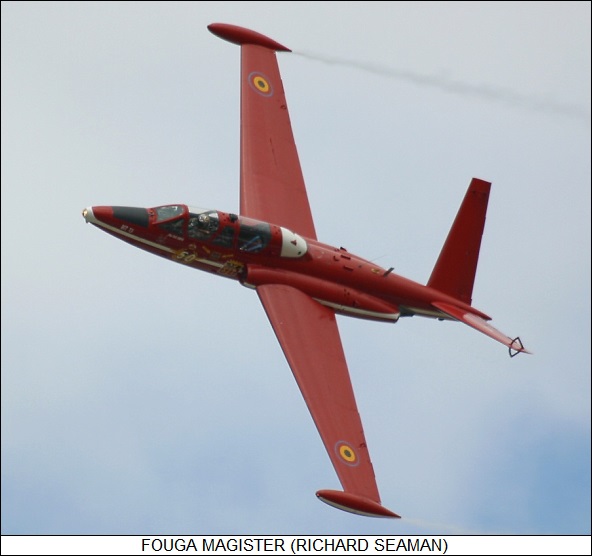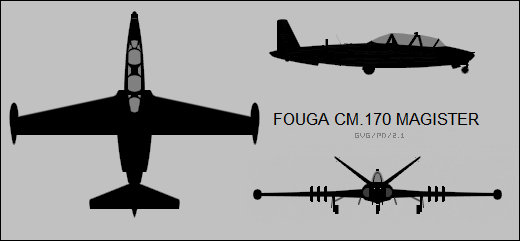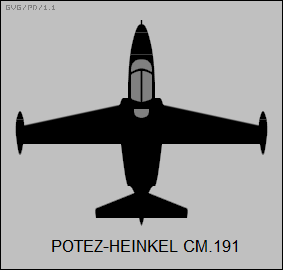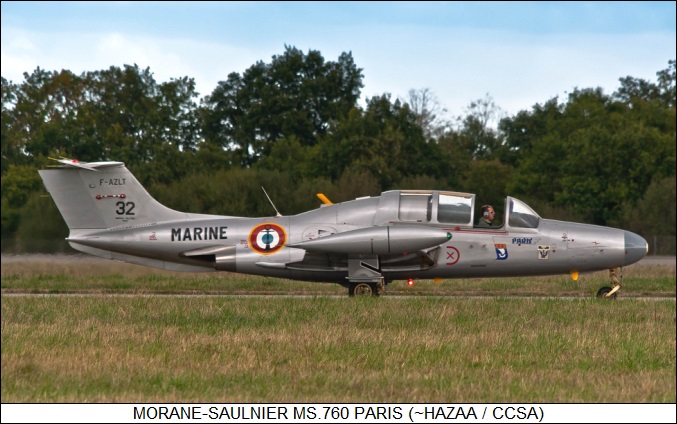
* In the 1950s, the French military acquired the world's first operational jet basic trainer, the Fouga "Magister", a tidy little aircraft that would serve with many air forces around the world. The same program that produced the Magister also led to the Morane-Saulnier "Paris" -- a four-seat jet that served with a number of air forces, and was one of the ancestors of the modern business jet. This document provides a history and description of the Magister and Paris.

* In the postwar period, the French Fouga company got into the jet age by way of jet-powered derivatives of the firm's CM.8 vee-tailed sailplane, using various Turbomeca small turbojets for propulsion. In 1948, in response to a requirement issued by the Ministere de l'Air (French Air Ministry) for a basic trainer, Fouga engineers came up with a tandem-seat twin-engine design, the "CM.130R", powered by two Turbomeca Palas small turbojets with 1.56 kN (160 kgp / 350 lbf) thrust each. The "CM", incidentally, stood for "Castello-Mauboissin", the aircraft's designers.
This proposal was not what the Air Ministry was looking for, so Fouga engineers went back to the drawing board to come up with a similar but larger and more capable aircraft, the "CM.170R", powered by twin Turbomeca Marbore turbojets providing 3.92 kN (400 kgp / 880 lbf) thrust each. The CM.170R proved more appealing and a contract was issued in December 1950. The first prototype performed its initial flight on 23 July 1952, with the other two prototypes flying in 1953.
Trials going well, an order was placed in June 1953 for ten evaluation copies of the "CM.170 Magister", as it was named, with the first evaluation machine performing its initial flight on 7 July 1954. An initial production order for the Armee de l'Air (AA / French Air Force) had already been placed in January 1954, with the first full production machine performing its initial flight on 29 February 1956.

* The Magister was of all-metal construction, with mid-mounted straight wings, featuring leading-edge sweep and wingtip tanks; a vee-style "butterfly" tail, with a strakelike ventral fin under the tail; a Marbore II turbojet mounted in a nacelle on each side of the fuselage; a tandem-seat cockpit, with individual rear-hinged clamshell canopies for the aircrew; and hydraulically-actuated tricycle landing gear. There were provisions for mounting twin 7.5- or 7.62-millimeter machine guns in the nose, and there was a pylon under each wing for carrying light external stores, such as a small bomb or small unguided rocket pod.
The wings featured a single spar; hydraulically-actuated one-piece slotted flaps; power-boosted ailerons; and triple air brakes on each wing, top and bottom. Leading-edge wing sweep was 13 degrees; wing incidence was 2 degrees, and there was no dihedral. The instructor in the back seat had a poor forward view and so a periscope, said to be more effective than it looked, was fitted on top of the canopy. All landing gear assemblies had single wheels, with the nose gear retracting backwards and the main gear hinging in the wings towards the fuselage. The landing gear was short, simplifying servicing by making most of the aircraft easier for ground crew to access. There was a small bumper wheel in the middle of the tail bottom fin.
___________________________________________________________________
FOUGA CM.170A MAGISTER:
___________________________________________________________________
wingspan with tanks:
11.4 meters (37 feet 5 inches)
wing area:
17.3 sq_meters (186.1 sq_feet)
length:
10.06 meters (33 feet)
height:
2.8 meters (9 feet 2 inches)
empty weight:
2,150 kilograms (4,740 pounds)
MTO weight:
3,200 kilograms (7,005 pounds)
max speed at sea level:
650 KPH (405 MPH / 350 KT)
service ceiling:
11,000 meters (36,000 feet)
range:
1,200 kilometers (735 MI / 640 NMI)
___________________________________________________________________
There were two fuel tanks in the fuselage, with a total capacity of 730 liters (193 US gallons). The standard wingtip tanks had a capacity of 125 liters (33 US gallons) each; although the wingtip tanks couldn't be discarded in flight, they could be swapped out on the ground for ferry tanks with a capacity of 230 liters (61 US gallons) each. The cockpit was pressurized and climate-conditioned. There were no ejection seats, though the twin canopies could be popped off in an emergency.
BACK_TO_TOP* The Aeronavale, the French naval air arm, obtained a variant of the CM.170 for carrier operations, fitted with a yoke-style arresting hook; catapult hookup; and reinforced, long-stroke landing gear. The prototype for the navalized version, the "CM.175 Zephyr" AKA "Magister Marine", performed its initial flight on 31 July 1956. Some sources also mention a single "CM.171" Magister, described as a testbed for the Turbomeca Gabizo turbojet, and lost in a crash in 1957.
Fouga was bought out by Potez in 1958, with development of the Magister continuing. The first "CM.170 Super Magister" -- some sources refer to it as the "CM.170-2" as opposed to the original "CM.170-1" -- performed its initial flight on 28 August 1962. The one significant change was fit of more powerful Marbore VI engines providing 4.71 kN (480 kgp / 1,058 lbf) thrust each. This was the only Magister follow-on to reach production, though it was not the only one built.

Potez built a prototype of a four-seat derivative, the "Potez-Heinkel CM.191", working in collaboration with Heinkel of Germany, with initial flight on 19 March 1962. It was generally similar to the Super Magister, with Marbore VI engines, the major difference being a new 2x2 cockpit. It appears to have been intended as a light liaison / executive transport aircraft.
Potez also attempted to perform further development of the basic Magister, flying a prototype of the "Potez 94" AKA "CM.173 Super Magister" on 8 June 1964. It retained the Marbore VI turbojets but featured a reprofiled nose, ejection seats, more fuel, and expanded armament options. Some sources say it entered production, but that didn't really happen.

Still further development of the basic Magister resulted in a prototype of the "Aerospatiale CM.90" -- Potez had been bought out in turn by Aerospatiale in 1967 -- which performed its initial flight on 20 August 1967. The CM.90 was highly modernized, with Turbomeca Astafan IIg turbofan engines, providing 7.75 kN (790 kgp / 1,740 lbf) thrust each; a raised cockpit to give the back-seater a better view; four stores pylons, allowing it to carry a more substantial warload; ejection seats; and other refinements. It deleted the wingtip tanks. Although it was a tidy aircraft, the competition with new-design trainers was too much, and there were no buyers.
* Trying to determine exact production quantities of Magisters is difficult, since no two sources agree closely. The most authoritative sources give total production as 929 machines up to 1971. It is known that the AA obtained 400 Magisters, with 130 of these being Super Magisters, while the Aeronavale obtained 32 Zephyrs, including two prototypes. The Magister was used as the mount for the AA's "Patrouille de France" flight demonstration team, until it was replaced by the Dassault-Dornier Alpha Jet trainer, which gradually replaced the Magister in AA service.

Germany obtained 250 Magisters, most of them built under license by Flugzeug Union Sud. Finland obtained 82, with 62 built by Valmet under license. Belgium obtained 45 for a joint NATO-Belgian-Dutch training program, with a few of these machines seeing combat in the Congo in 1960. Five more were replaced from German Luftwaffe stocks in the 1970s, when the Magister was used as the mount for the Belgian "Rode Duivels / Diables Rouges (Red Devils)" flight demonstration team for a time.
Belgian Magisters were replaced in the training role by the Alpha Jet in the late 1970s. However, the Magister was cheap to operate, reliable, and so safe and fun to fly that it was retained in service in the role of as squadron "hack" into the 21st century. A few of the Magisters were occasionally repainted in flaming Red Devil colors to put on displays at airshows.
The Israelis obtained 52, with 36 built by Israel Aircraft Industries (IAI). The Israelis also put the Magister into combat, employing it for attacks during the June 1967 War. It was mainly used for diversions, or in combat emergencies when nothing else was available; its armament was mostly for weapons training, and it didn't really have the warload, performance, or survivability to be a very good combat weapon. Seven were lost in action.
The Israelis liked the Magister so much that they obtained Luftwaffe hand-me-downs, and in the 1980s about 80 of them were put through a significant upgrade program, conducted by the Bedek division of IAI. The "Advanced Multimission Improved Trainer (AMIT)" AKA "Tzukit (Thrush)" included ejection seats, improved avionics, and other modernized systems. The AMIT could not carry armament, but it was capable of performing the photo-reconnaissance mission. IAI Bedek promoted an upgrade program for Magisters operated by other nations, but there's little evidence there were any takers.
Other buyers included Austria, Brazil, Cambodia, the Congo, Ireland, and Lebanon. Second-hand machines were obtained by a number of air forces of smaller nations, including Bangladesh, El Salvador, Morocco, and a list of others that varies from source to source. It is unlikely that any Magisters are still flying in government service, but refurbished Magisters have a strong presence on the airshow circuit as private "warbirds".
BACK_TO_TOP* The Magister was evaluated by the AA in competition with a side-by-side jet trainer, the Morane-Saulnier "MS.755 Fleuret", which performed its initial flight on January 1953.

With the rejection of the Fleuret, Morane-Saulnier didn't give up, instead developing a prototype of a four-seat (with 2x2 seating) liaison aircraft based on the Fleuret, which emerged as the "MS.760 Paris I" -- though it was originally known as the "Fleuret II". Initial flight of the MS.760 was on 29 July 1954, with Jean Cliquet at the controls. Both the AA and the Aeronavale evaluated the type and decided it fit their needs, with the first production machine performing its initial flight on 27 February 1954. Initial deliveries were in 1959, with the Aeronavale obtaining 14 machines and the AA obtaining 36.
The MS.760 featured a low-mounted straight wing, a tee tail, and tricycle landing gear. The wing had a dihedral of 8 degrees and an incidence of 2 degrees. The Paris was powered by twin Turbomeca Marbore II turbojets, providing 3.92 kN (400 kgp / 882 lbf) thrust each, an engine being fitted in each wingroot. The main fuel tank, in the fuselage, had a capacity of 950 liters (250 US gallons); wingtip tanks could be fitted, each with a capacity of 225 liters (59.4 US gallons). All landing gear assemblies featured single wheels and were electrically actuated -- the nose gear retracting backwards, and the main gear retracting from the wings towards the fuselage.

The cockpit was pressurized, air-conditioned, and featured dual controls. There were no ejection seats, but the sliding canopy could be discarded in an emergency. The rear seats could be easily removed to configure the aircraft for trainer or aerobatic use. Like the Magister, for weapons training the Paris could be fitted with twin light machine guns in the nose and could carry light external stores.
___________________________________________________________________
MORANE-SAULNIER MS.760 PARIS:
___________________________________________________________________
wingspan:
10.15 meters (33 feet 3 inches)
wing area:
18 sq_meters (193.7 sq_feet)
length:
10.05 meters (33 feet)
height:
2.6 meters (8 feet 6 inches)
empty weight:
1,945 kilograms (4,280 pounds)
MTO weight:
3,470 kilograms (7,560 pounds)
max speed at sea level:
650 KPH (405 MPH / 350 KT)
service ceiling:
10,000 meters (32,800 feet)
range:
1,500 kilometers (930 MI / 810 NMI)
___________________________________________________________________
The Fleuret, incidentally, had the same general arrangement as the Paris, except for the two-seat cockpit, and slightly smaller dimensions: a span of 9.65 meters (31 feet 8 inches) and a length of 9.8 meters (32 feet 2 inches).
Along with purchases by the AA and Aeronavale, 36 Paris jets were assembled in Argentina from factory-supplied knockdown kits. French production moved on to the "MS.760 Paris II" in 1961, which featured more powerful Marbore IV turbojets with 4.71 kN (480 kgp / 1,058 lbf) thrust, plus integral tankage in the wing leading edges providing 440 liters (116 US gallons) additional fuel capacity, electrical engine inlet de-icing, and general systems improvements. Some Paris Is were updated to Paris II configuration.

A single prototype of an "MS.760C Paris III" civil executive jet was flown and publicly demonstrated at the Paris Air Salon in 1961. Although there had been an effort to sell the original Paris to the civilian market, the type had not been attractive to most civilian users because of the need to clamber into the cockpit; the Paris III featured a redesigned cockpit with a car-type door on the left side and seating for five. The wing was reprofiled and the wingtip tanks were deleted. However, by that time the Gates Learjet had been introduced, and Paris III was not competitive. The Paris III was used by Aerospatiale as a utility aircraft, and is now on static display at the Le Bourget air museum.
Total Paris production is generally given as 165. Along with France and Argentina, Brazil obtained 30, the Netherlands 7, with small quantities sold to Peru, Italy, Germany, the Bahamas, Morocco, Iran, and a number of other countries. The Aeronavale retired the last French military Paris in 1997; the Argentine military phased out the type in 2007. Ironically, despite the failure of the Paris in the civilian market, thanks to the large number of retired machines, the Paris found a new life in private ownership. Dozens of refurbished aircraft, often with modernized avionics, went into civilian hands, in many cases sporting snazzy and very un-military color schemes.
BACK_TO_TOP* It was difficult to find sources on the Magister and Paris, and mostly I had to rely on such volumes of JANE'S ALL THE WORLD AIRCRAFT as I could find. I found some materials online, but they weren't particularly trustworthy -- I know this reflects badly on my own work, but the internet is the least reliable source of information.

* Revision history:
v1.0.0 / 01 jun 08 v1.0.1 / 01 apr 10 / Review & polish. v1.0.2 / 01 mar 12 / Review & polish. v1.0.3 / 01 feb 14 / Review & polish. v1.0.4 / 01 jan 16 / Review & polish. v1.0.5 / 01 dec 17 / Review & polish. v1.0.6 / 01 oct 19 / Review & polish. v1.0.7 / 01 aug 21 / Review & polish. v1.0.8 / 01 jul 23 / Review & polish. v1.0.9 / 01 jun 25 / Review & polish.BACK_TO_TOP
